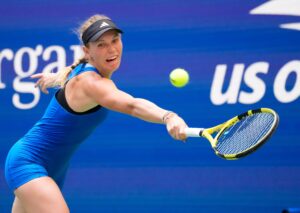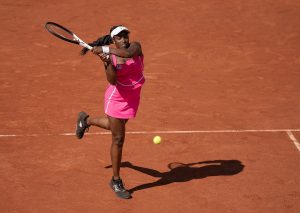BIRMINGHAM, UK–
On-court coaching in tennis is always something that divides opinions. Some people love the idea and the way it is implemented, while others struggle to see what value it adds to the women’s game and would prefer to see it end. I will take an in-depth look at what I feel are the positives and negatives of this addition and whether it should even be applied even more extensively at the higher levels of the sport.
On-court coaching first made its initial arrival on the WTA tour in 2009. At first it was an initiative that was being used on a trial basis, but fast-forward ten years and it is still happening in women’s tennis, albeit with some criticism attached to it at times.
Pros and cons
One positive about on-court coaching is the fact that it allows a top-level coach to get involved when he/she or their player sees fit. This can make a huge impact on the overall course of a match. One brief chat can alter the balance of power, alternate the tactics their player was originally using ,and it can seriously be the difference between a player losing or winning a big title.
It can also be argued that a coach already has a huge influence on the way a player plays and competes on a tennis court, so why not give that coach the freedom to have even more of a positive or negative impact in the middle of match play. There are certainly players that do make the most of on-court coaching more than others. For example, Caroline Wozniacki is one of the main players known for calling her father Piotr to the court at any time of desperate need, even she’s winning by a slender margin. But she nearly always relies on her father’s input when she’s in a losing position in the scoreboard.
There are definitely other players that don’t see the benefits of using on-court coaching on a regular basis. On-court coaching is limited to regular tour events, but it still isn’t allowed at all of the four Majors, so some players tend to be put off from using it. When well-respected Australian coach David Taylor was working with former US Open champion Sam Stosur, they never made the most of the option of on-court coaching. In many ways it can be seen as something that can work against them on the grandest of stages at the Majors. A player can become over-reliant on it at the regular events, then discover that they struggle when trying to problem-solve their way out of danger during the Grand Slam matches, which is why some are consistent in not using it whatsoever.
Enhances the viewing experience
For me, I think at times it can give the tennis fans watching at home a greater insight into not only how the player reacts to pressure situations, but also gives a rare look at the personality of the coach in question. Often in the sport of tennis we learn a great deal about the best players in the world. We know what they like, what they don’t like, their strengths and weaknesses. We very rarely learn that much about the man or woman behind the player and what they have to offer.
On-court coaching is something that addresses that, and giving greater access to the coaches can only really be a good thing. On top of that, it is always intriguing to see how a player responds to the coach’s information in the points and games that follow. Not only does it enhance the overall experience for a casual or dedicated tennis viewer, but it enables them to broaden their tennis knowledge as a result.
Some would argue the contrary. For the overall experience as a tennis viewer, watching at home isn’t always enhanced by on-court coaching. A prime example of that are the ongoing discussions we see between the likes of two-time Grand Slam champion Garbine Muguruza and her long-time coach Sam Sumyk, which sometimes can be uncomfortable to watch. Not that much is gained from the short few minutes of listening in on their conversations. Sometimes you see heated discussions, a short on-court coaching visit with not much input, and it can be a poor experience for all parties involved.
Is on-court coaching fair?
The next part of the discussion I really want to move on to is whether on-court coaching is fair? Is it something that should be relied upon when players already have a long period of time before matches to make tactical adjustments to the player they are facing? Should that be where the coaching starts and ends in our sport?
You can argue the case that a player should be able to problem-solve their way out of matches themselves, and really find a way to get the job done tactically and mentally during their matches. At the end of the day, tennis is an individual sport, and as a viewer you want to see the best players work things out for themselves and make the necessary changes under pressure as they go along. Bringing a coach onto the court in the heat of battle sometimes can feel a tiny bit unfair and takes the individuality of tennis in singles action away. Tennis is a one-on-one battle between two players. To a certain degree, allowing coachingactually takes something special away from the game we love.
Also, not every tennis player has the luxury of being able to afford a coach on a consistent basis. So you really have to wonder whether the on-court coaching rule is something that only really benefits the higher-ranked players, who have the financial flexibility to bring a coach with them. The lower-ranked players struggle to break even, so the thought of employing a top-level coach throughout the whole season is something that they can’t even consider.
You simply have to wonder whether the rule offers a level playing field for all players. Does it treat those ranked No.1 in the world or just outside the World’s Top 150 evenly? If a rule like this is going to be enforced potentially at the Grand Slams, then it has to be inclusive and fair. Otherwise we are going to just see an even greater gap between the higher-ranked players and the players struggling to make a living at the lower echelons of the tennis tour.
The most notable and strongest argument when it comes to backing the use of on-court coaching really falls with television. Many will argue the case that it adds a bit of life and spice to a tennis match and can give a dismal, uneventful matchup a bit of a facelift in some ways. The drama and entertainment factor can’t be overlooked, and to some portions of the tennis world that is a viable reason to continue to push on-court coaching. We not only learn more about players we generally know very little about, but we get an even greater look into the minds of some of the best players in the world who are household names on tour.
Naomi Osaka weighs in
Naomi Osaka was asked about on-court coaching and whether she’d like to see more of it on the women’s tour. The Japanese player very much pointed to the potential for greater entertainment in our sport. “But, I mean, I don’t think on-court coaching is bad because I think people want to know, like, what could be going on, you know. Like, during the NBA they have a coach’s break sometimes and I think that is kind of interesting to see what they are thinking about. I’m not the one to be asking that [smiling]. So, yeah.”
Osaka is one of the younger players on tour, and her positive feelings towards on-court coaching is huge. I think what on-court coaching can do in a positive way is actually bring a younger generation into the sport that wouldn’t necessarily be as interested without the presence of coaching on court. Not only is it important to continue to appeal to the masses that already enjoy following the sport on a consistent basis, but it is just as important to be able to bring new fans from different generations, and attracting young fans is vital for the longevity of the sport as a product. Osaka very much backs up the idea I said before. There seems to be an interest in getting into the minds of coaches, but also looking at the interactions between a player and a coach. As much as there are clear problems and issues with the thought of on-court coaching, there are certainly very good reasons like the entertainment factor that can’t really be ignored or overlooked.
Main Photo:
Embed from Getty Images






